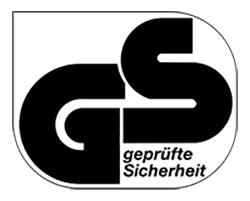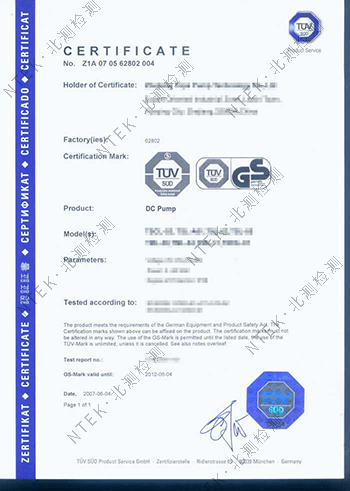Introduction to German GS certification
GS means German "Geprufte Sicherheit" (safety certified) and also means "Germany Safety". GS certification is a voluntary certification based on the German Product Safety Law (GPGS) and tested in accordance with the EU's unified standard EN or German industrial standard DIN. It is a recognized German safety certification mark in the European market.

GS certification mark
The GS certification mark indicates that the product's safety has been tested by credible independent agencies. Although the GS certification mark is not required by law, it can indeed make manufacturers subject to strict German (European) product safety laws when a product fails and causes an accident. Therefore, the GS certification mark is a powerful market tool that can enhance customer confidence and purchase desire. Although GS is a German standard, most countries in Europe agree. And while meeting the GS certification, the product will also meet the requirements of the European Community CE mark. Unlike CE, there is no legal requirement for the GS certification mark, but as safety awareness has become more common among consumers, an appliance with the GS certification mark may be more competitive in the market than ordinary products. Generally, GS certified products have higher sales prices and are more popular.
Significance of certification
The need for GS certification
1. GS, as a symbol of product safety and reliable quality, has been more widely recognized by German and EU consumers;
2. Minimize the manufacturer's liability risk in product quality;
3. Enhance manufacturers' confidence in product quality, safety, and compliance with legal requirements;
4. Emphasize to consumers the obligations of manufacturers on product quality and safety;
5. Manufacturers can assure end users that products bearing the GS mark have passed the tests of third-party testing organizations;
6. In many cases, the quality and safety of products with the GS logo exceeds the level required by law;
7. The GS mark can obtain higher recognition than the CE mark, because the GS certificate is issued by a qualified third-party testing agency.
Applicable product range
1. Household appliances, such as refrigerators, washing machines, kitchen appliances, etc.
2. Household machinery.
3. Sports supplies.
4. Household electronic equipment, such as audiovisual equipment.
5. Electrical and electronic office equipment, such as copiers, fax machines, paper shredders, computers, printers, etc.
6. Industrial machinery and experimental measurement equipment.
7. Other safety-related products such as bicycles, helmets, ladders, furniture, etc.
Application process
1. Application: The applicant submits documents that meet the requirements. For electrical products, documents such as the assembly drawing, electrical schematic diagram, bill of materials, product use or installation instructions, and differences between the series models are required.
2. Sample test: The test will be performed in accordance with the applicable standards. It can be performed in the manufacturer's laboratory or any of the inspection agencies in countries' laboratories.
3. Factory inspection: GS certification requires inspection of safety-related procedures at the production site.
4. Issue GS certificate.
Application materials
1. Application form
2. General agreement
3.CB certificate and report of the product
4. Product instruction manual
5, parts list
6.Circuit diagram and layout
7, the structure of the product
8.Specifications of transformers and other components
9.Nameplate
10. Electromagnetic compatibility evaluation report (EMC) and factory compliance statement (DOC)
11.German manual
12, samples during shipment
Certificate information
 Hot Line
400-800-6106
Hot Line
400-800-6106

